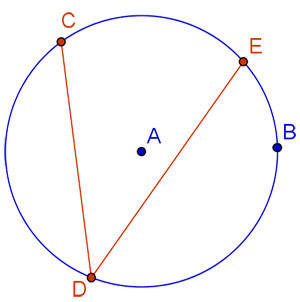
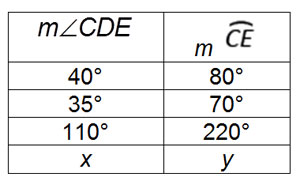
Angie used the dynamic geometry software sketch below to generate the table of data shown.
 |
 |
Which of the following conclusions is best supported by the data that Angie collected?

A
Correct! The measure of the inscribed angle is equal to half of the measure of the intercepted arc.
B
Incorrect. Take a second look at the values in the two columns. If you know the value of x, how can you generate the corresponding value for y?
C
Incorrect. Take a second look at the values in the two columns. If you know the value of x, how can you generate the corresponding value for y?
D
Incorrect. Take a second look at the values in the two columns. If you know the value of x, how can you generate the corresponding value for y?
A company's corporate logo is the following shape:
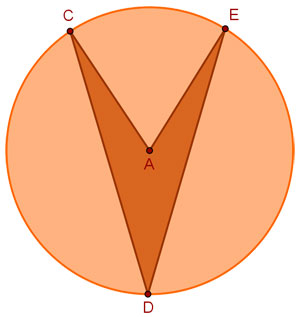
If m∠CAE = 64°, what is m∠CDE ?
A. 64°
Incorrect. What types of angles are ∠CAE and ∠CDE?
B. 32°
Correct !The measure of an inscribed angle is equal to half the measure of its corresponding central angle.
C. 128°
Incorrect. If you know the measure of a central angle, how do you find the measure of an inscribed angle?
D. 116°
Incorrect. What types of angles are ∠CAE and ∠CDE?
Chien is investigating relationships among inscribed angles in a circle using the dynamic geometry sketch shown below.
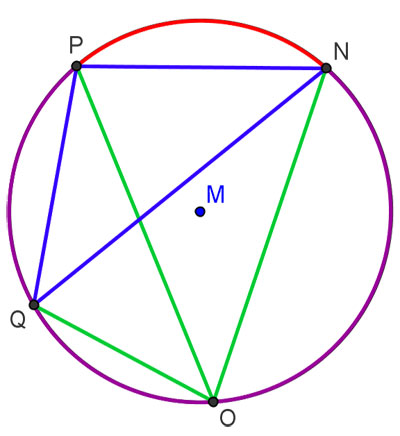
Which of the following tables would help Chien to inductively determine that if two inscribed angles intercept the same arc, then the angles are congruent?
|
m∠QPN
|
m∠QON
|
|
110°
|
70°
|
|
120°
|
60°
|
|
130°
|
50°
|
|
140°
|
40°
|
|
150°
|
30°
|
|
m∠PQN
|
m∠NQO
|
|
40°
|
60°
|
|
50°
|
60°
|
|
60°
|
60°
|
|
70°
|
60°
|
|
80°
|
60°
|
|
m∠PQN
|
m∠PON
|
|
40°
|
50°
|
|
45°
|
45°
|
|
50°
|
40°
|
|
55°
|
35°
|
|
60°
|
30°
|
|
m∠PQN
|
m∠PON
|
|
40°
|
40°
|
|
45°
|
45°
|
|
50°
|
50°
|
|
55°
|
55°
|
|
60°
|
60°
|
A
Incorrect. Find two inscribed angles that intercept the same arc.
B
Incorrect. Find two inscribed angles that intercept the same arc.
C
Incorrect. These two inscribed angles intercept the same arc, but the table does not show that they have the same measure, and congruent angles have the same measure.
D
Correct! These two inscribed angles both intercept ∠PN, and the table shows that since they have equal measures, they are congruent.
In the diagram below, DY is a diameter of Circle A.
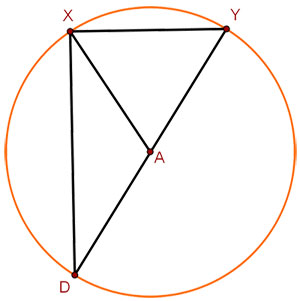
Which of the following is a valid conclusion from the figure?
Gilberto used dynamic geometry software to generate the figures shown below.

Which of the following conclusions is best supported by the data Gilberto collected?
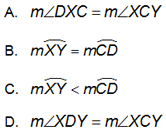
A
Incorrect. Which two angles in the figures have equal measures?
B
Incorrect. Which arc is intercepted by the two angles with equal measures?
C
Incorrect. Which arc is intercepted by the two angles with equal measures?
D
Correct! Gilberto’s sketches show that when two inscribed angles intercept the same arc, they have equal measures regardless of where the arc is or where the vertices of the angles are.